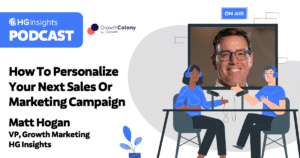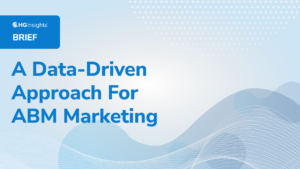Account-Based Marketing (ABM) platforms continue to be a sought-after solution in SaaS and B2B marketing. And for good reason. You need to get in front of decision makers — people at high-value accounts who can pull the trigger on your (probably expensive) product — but decision makers are hard to reach.
That’s where ABM platforms come into play.
I always talk about “Account-Based Everything.” Your whole organization should be thinking about prospects — which companies are the best fit and most likely to buy your product — and focus your marketing and sales teams’ efforts on those.
But developing an ABM campaign can be challenging: They take a long time to create and see ROI, it’s hard to narrow down the accounts to target, and the content needs to be hyper-personalized to spark engagement. In short, executing an ABM strategy takes a lot of resources. But you have to be willing to grind to build your outbound engine.
As the VP of Growth Marketing at HG Insights, my team’s responsibility is all things growth. That includes demand generation, content marketing, email, you name it, and we use an account-based marketing philosophy for everything. Despite the challenges, we’ve seen tremendous success by implementing the right ABM platforms into our marketing strategy.
What is an ABM Platform?
An ABM platform is a software solution that helps businesses identify, target, and engage with high-value companies. It aligns sales and marketing efforts by delivering personalized and targeted campaigns to key accounts. ABM platforms support campaign orchestration across marketing channels including in content, advertising, website, and email. With ABM tools, you can effectively target your Ideal Customer Profile (ICP) accounts and deliver personalized messaging to improve marketing and sales outcomes.
Key features of ABM platforms include:
- Account Identification: Utilizes data to identify and prioritize target accounts based on predefined criteria such as revenue potential, industry, and geography.
- Personalization Tools: Creates customized content for specific target accounts based on their needs and characteristics.
- Intent Data: Identifies signals that indicate the likelihood of key accounts to buy a product or service.
- Multi-Channel Targeting: Supports targeting on different channels such as email, social media, digital advertising, and direct mail.
- Lead Scoring: Assigns scores to leads based on their engagement and fit with target account criteria. This helps prioritize accounts for sales follow-up.
- Marketing Automation: Streamlines the execution of ABM campaigns by automating repetitive tasks and coordinating efforts between marketing and sales teams.
- Analytics and Reporting: Provides insights into campaign performance to measure the effectiveness of your ABM strategy and adjust accordingly.
- Integrations: Works with CRM systems to align campaign activities with sales and marketing teams.
Benefits of Account-Based Marketing Software
Account-based marketing software has become essential for account targeting in 2024. However, it wasn’t long ago that it didn’t exist.
Engagio (founded by Jon Miller, who also founded Marketo) was the first ABM platform and came to market around 2016. This shows you how new ABM platforms are. Up until then, automation was limited to marketing emails — even sales automation tools like Salesloft and Outreach.io were just beginning. Marketing and sales teams had to put in the work — writing emails, following up, then following up again — it was a slog to execute multi-channel tactics. ABM software changed all that.
The benefits of ABM can’t be overstated and ABM platforms enable you to:
- Focus on High-Value Accounts: Concentrate marketing and sales resources on the most promising accounts to maximize ROI.
- Enhance Personalization: Tailor content and messaging to the specific needs and characteristics of target accounts.
- Improve Collaboration: Facilitate better alignment between marketing and sales teams by providing a unified platform for planning, executing, and analyzing account-specific campaigns.
- Increase Conversion Rates: ABM platforms boost revenue growth by providing relevant content to targeted accounts, increasing engagement and conversion rates.
5 ABM Platforms to Drive Your Strategy
While ABM platforms run the gamut in terms of quality, capability, and pricing, there are several that a B2B marketer simply can’t execute their strategy without. Here are the top ABM tools that HG Insights uses to target accounts, and the up-and-coming ABM platforms that are making waves in the industry.
1. HG Insights – Best for Account Targeting
With the world’s largest database of Technology Intelligence, HG Insights is the go-to for account planning, including identifying target accounts, segmenting, and building audience lists for your ABM campaigns. The HG Insights Platform provides access to granular, account-level insights on companies worldwide that include technographic, firmographic, and intent data. This incredibly robust data allows you to target accounts with precision, ensuring your ABM campaigns are a success.
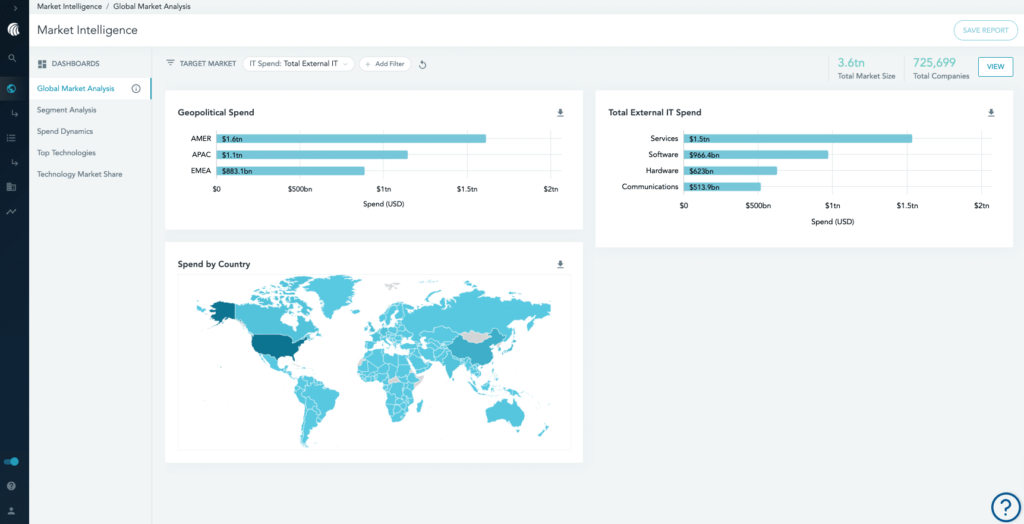
While HG’s database is vast, the platform is intuitive and easy to use. By applying filters, you can drill down into your market by industry, region, IT spend, technology installations, employee count, and more to uncover your ideal accounts. The data easily integrates with Salesforce and LinkedIn, so you can import accounts directly into your sales and marketing platforms.
Without the data to build your audience list, your ABM campaign will never be successful. And that’s where HG Insights comes in — helping B2B companies understand what technology choices their target accounts are making, how much they are spending on over 140 areas of IT, and what they may intend to purchase next. With this account intelligence you can uncover your Total Addressable Market (TAM) and identify and prioritize accounts for your ABM campaigns based on their fit and likelihood to buy your product.
2. RollWorks – Best for Account-Based Advertising
RollWorks is the ultimate wingman if you’re looking to land a big account. The account-based marketing platform is designed to help you identify, engage, and convert high-value accounts through targeted ad campaigns. RollWorks offers a ton of benefits for ABM, such as account scoring and audience matching, and the platform has excellent analytics and reporting — you can easily see which ads are working, which are not, and use those insights to inform your ABM strategy.

RollWorks helps create effective ABM campaigns by allowing for a more personalized and targeted approach to paid advertising. But nothing is perfect and RollWorks has its own set of challenges. While the ABM platform offers robust advertising capabilities, it can take some time to master. But if you’re willing to put in the effort, the rewards are well worth it because you can get your targeted ads in front of the right prospects.
3. Dux-Soup – Best for Account-Based Sales Tactics
Dux-soup is a LinkedIn automation tool that helps businesses generate leads, build connections, and grow their network on social media. With Dux-soup, you can automate many of the repetitive, time-consuming tasks associated with LinkedIn prospecting and outreach, such as sending connection requests, personalized messages, and follow-ups.
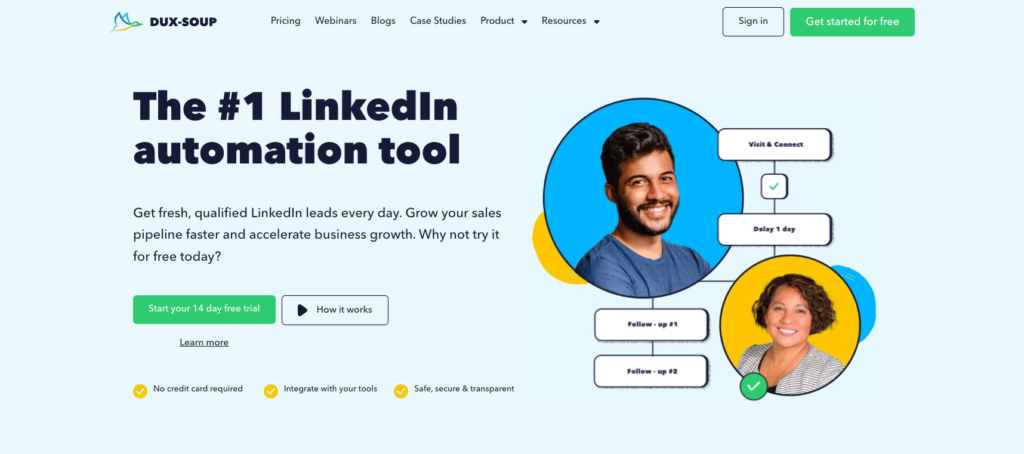
Perfect for sales teams, the ABM platform also allows you to extract and export valuable data from LinkedIn profiles, such as contact information and job titles, to create targeted lead lists. Dux-Soup integrates with most CRM systems to streamline the sales process and improve overall efficiency.
4. Sendoso – Best for Direct Mail
No, direct mail isn’t dead, and Sendoso is proof. The ABM platform makes it easy to create, manage, and track a wide range of sending campaigns including direct mail, handwritten notes, and custom gifts.
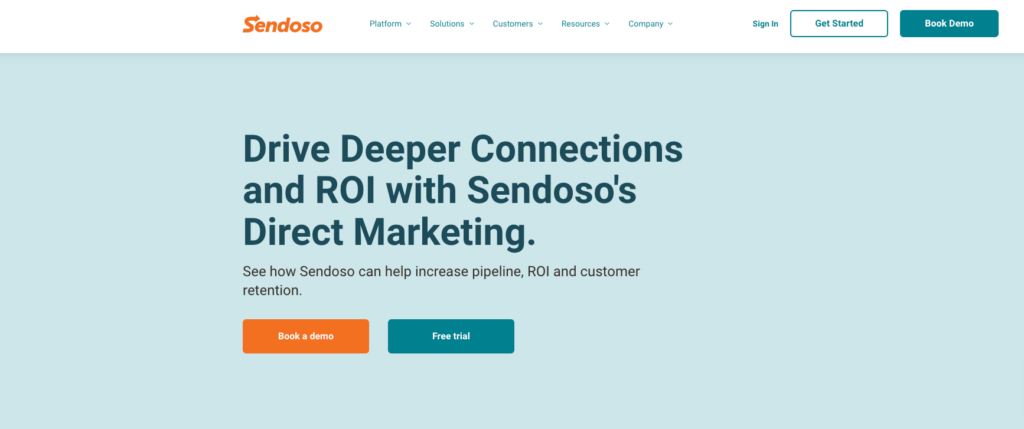
The benefits to Sendoso are many. For one, you can establish a personal connection with customers and prospects, which is essential for building long-term relationships. Sendoso also reduces the time it takes to execute direct mail campaigns and provides reporting features, so you can measure the impact of your ABM strategy.
At HG Insights, we use Sendoso to send gift cards, swag, and even branded cupcakes to high-value accounts. A personalized gift goes a long way in sticking in the hearts and minds of your customers and prospects. We’ve seen a lot of success using Sendoso to go the extra mile.
5. Mutiny – Best for Web Personalization
Mutiny is an account-based marketing tool that allows you to personalize website content for your target accounts. Imagine you could send any prospect, from any industry, to a landing page that speaks directly to their specific pain points and interests. Voilà! Mutiny does that.
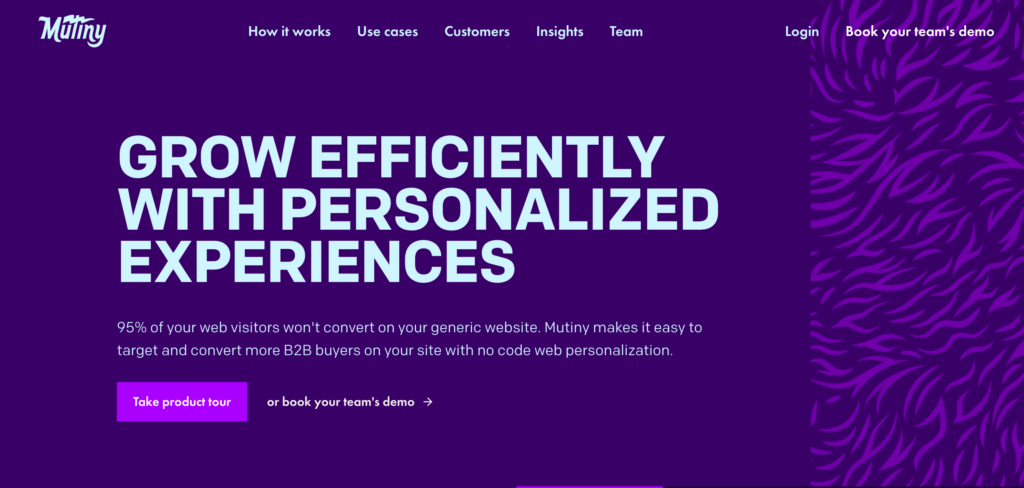
By leveraging data and analytics, Mutiny delivers customized website experiences to each visitor and helps tailor messaging and content to their specific needs and interests. In short, Mutiny takes the manual labor out of building personalized web pages. This ABM platform is an excellent resource if you want to create a customized buyer’s journey and enhance your ABM campaigns.
Choosing the Right ABM Platforms
ABM is essential for B2B marketing. It boosts revenue, creates high-quality leads, and aligns sales and marketing. However, choosing the right ABM platforms for your company isn’t easy. Before making any purchasing decisions, ensure the software you’re considering has the features you need and integrates with your existing tech stack.
To discover why HG is a game-changer for account targeting and audience building — reach out! We provide account-level insights and sales intelligence to help you launch successful ABM campaigns. Our team is standing by to answer any questions you have.
